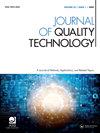贝叶斯网络的例子
IF 2.2
2区 工程技术
Q2 ENGINEERING, INDUSTRIAL
引用次数: 8
摘要
这本清晰、结构良好的书是同一作者2014年出版的《贝叶斯网络与r中的例子》的第二版。除了第一版中涵盖的核心材料外,新版扩展了几个主题,如条件高斯贝叶斯网络、动态贝叶斯网络和一般贝叶斯网络等。值得一提的是,这本书有一个网站和相关的R包“bnlearn”,其中可以下载书中使用的R代码,并提供了额外的示例。这本书可以适用于入门贝叶斯网络课程在硕士或博士水平。第1章到第4章遵循类似的结构来介绍几种类型的贝叶斯网络。每章介绍贝叶斯网络的图形和概率表示,参数估计,结构学习,推理和贝叶斯网络绘图。第一章主要讨论离散数据的多项式贝叶斯网络,第二章主要讨论连续数据的高斯贝叶斯网络。在这两章中,所有变量都遵循属于同一族的概率分布,要么是多项式分布,要么是正态分布。第3章介绍了条件高斯贝叶斯网络,它是一种“混合正态”模型,其中连续节点可以有连续和离散的父节点,而离散节点只能有离散的父节点。本章演示了在构建贝叶斯网络时结合不同的概率分布族的初始步骤。第4章讨论了动态问题的动态贝叶斯网络,其中一些变量可以随时间演变,因此在不同时间测量的变量可以被视为贝叶斯网络中的不同节点。第5章介绍了一般的贝叶斯网络,其中每个变量都用最合适的分布来建模,而不是局限于服从多项式或正态分布。由于这是贝叶斯网络构建的一种更普遍的情况,因此采用Stan(一种利用马尔可夫链蒙特卡罗抽样进行贝叶斯统计推断的开源软件)及其R接口“rstan”进行随机抽样和参数估计。第6章介绍了贝叶斯网络的理论基础,介绍了贝叶斯网络的形式化定义及其性质,并介绍了贝叶斯网络的学习和推理算法。本章还讨论了两个重要的主题:学习因果贝叶斯网络的假设和挑战是什么;以及评估贝叶斯网络需要考虑什么。第7章概述了用于贝叶斯网络开发的软件包。表格中列出了许多R包,以及每个包处理离散和/或连续数据的能力的信息,以及它对结构学习、参数学习和推理的支持。本章讨论了Stan及其特性,并简要介绍了几个商业软件包。第8章介绍了生命科学中的两个实际应用。第一个应用说明了如何构建贝叶斯网络来发现人类细胞中表征生物过程的相互作用和途径。第二个应用侧重于设计一种预测方法,通过学习贝叶斯网络来预测人体成分。此外,概率论、统计和图论的介绍性材料以及习题的解答都包含在本书的末尾。总之,这本书提供了真实世界的例子和大量的R代码来展示贝叶斯网络在广泛应用领域的潜力,我相信这对学者和实践者都是非常有益的。此外,本书中使用的主要R包“bnlearn”是由第一作者开发和维护的,读者可以在网站上访问R代码和其他示例。本文章由计算机程序翻译,如有差异,请以英文原文为准。
Bayesian networks with examples in R
This clear and well-structured book is the second edition of the same authors’ 2014 book, Bayesian Networks With Examples in R. In addition to the core material covered in the first edition, the new edition expands several topics such as conditional Gaussian Bayesian networks, dynamic Bayesian networks, and general Bayesian networks, etc. It’s worth mentioning that there is a website for this book and the related R package, “bnlearn”, in which the R code used in the book can be downloaded and additional examples are provided. This book can be suitable for an introductory Bayesian network course at the MS or PhD level. Chapters 1 to 4 follow a similar structure to introduce several types of Bayesian network. Each chapter presents graphical and probabilistic representation of Bayesian network, parameter estimation, structure learning, inference, and Bayesian network plotting. Chapter 1 focuses on multinomial Bayesian network for discrete data, whereas Chapter 2 on Gaussian Bayesian network for continuous data. In these two chapters, all the variables follow probability distributions belonging to the same family, either multinomial or normal. Chapter 3 introduces conditional Gaussian Bayesian network that is a “mixture of normals” model in which continuous nodes can have both continuous and discrete parents while discrete nodes can only have discrete parents. This chapter demonstrates an initial step to combine different families of probability distributions in building a Bayesian network. Chapter 4 discusses dynamic Bayesian network for dynamic problems in which some variables can evolve over time, therefore a variable measured at different times can be treated as different nodes in Bayesian network. Chapter 5 presents general Bayesian network in which each variable is modeled by its most suitable distribution rather than limited to follow multinomial or normal distribution. Since this is a more general case for Bayesian network building, Stan (an open source software for Bayesian statistical inference using Markov chain Monte Carlo sampling) and its R interface, “rstan”, are adopted to perform random sampling and parameter estimation. Chapter 6 covers theoretical foundations for Bayesian network, in which the formal definition of a Bayesian network and its properties are introduced, and the algorithms for Bayesian network learning and inference are included. This chapter also discusses two important topics: what are the assumptions and challenges in learning a causal Bayesian network; and what considerations are needed to evaluate a Bayesian network. Chapter 7 provides an overview of software packages for Bayesian network development. A number of R packages are listed in a table, along with information on each package’s capability to handle discrete and/or continuous data, as well as its support for structure learning, parameter learning, and inference. Stan and its features are discussed, and several commercial software packages are briefly mentioned in this chapter. Chapter 8 presents two real-world applications in life sciences. The first application illustrates how to build a Bayesian network to discover the interactions and the pathways characterizing biological processes in human cells. The second application focuses on designing a predictive approach that learns a Bayesian network to predict human body composition. Moreover, introductory material on probability, statistics and graph theory and the solutions to the exercises are included at the end of the book. In summary, this book provides real-world examples with extensive R codes to demonstrate the potential of Bayesian networks in a wide range of application areas, which I believe is extremely beneficial for both scholars and practitioners. Furthermore, the major R package used in this book, “bnlearn”, is developed and maintained by the first author, and a website is available for readers to access the R code and additional examples.
求助全文
通过发布文献求助,成功后即可免费获取论文全文。
去求助
来源期刊

Journal of Quality Technology
管理科学-工程:工业
CiteScore
5.20
自引率
4.00%
发文量
23
审稿时长
>12 weeks
期刊介绍:
The objective of Journal of Quality Technology is to contribute to the technical advancement of the field of quality technology by publishing papers that emphasize the practical applicability of new techniques, instructive examples of the operation of existing techniques and results of historical researches. Expository, review, and tutorial papers are also acceptable if they are written in a style suitable for practicing engineers.
Sample our Mathematics & Statistics journals, sign in here to start your FREE access for 14 days
 求助内容:
求助内容: 应助结果提醒方式:
应助结果提醒方式:


